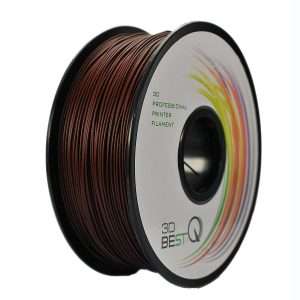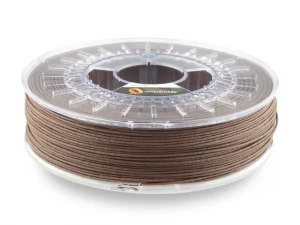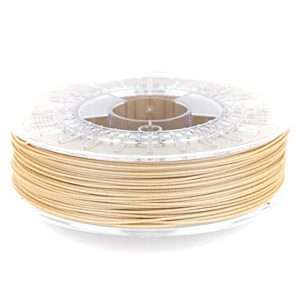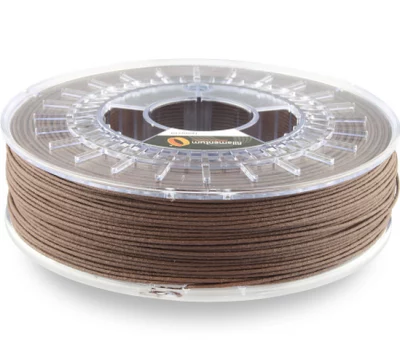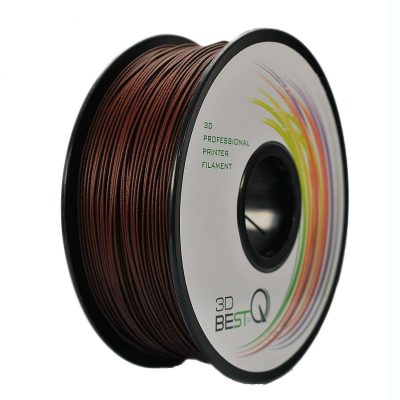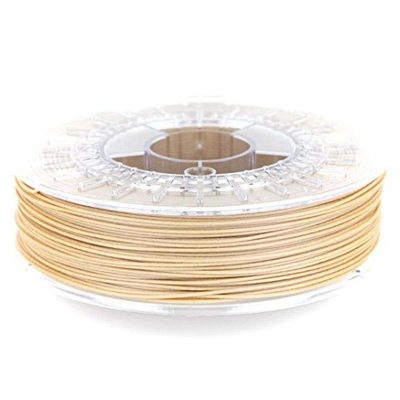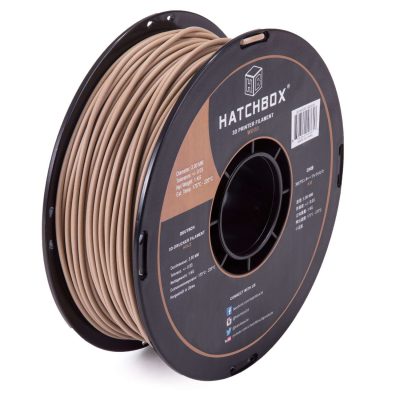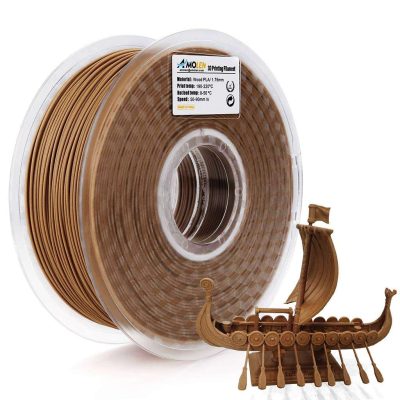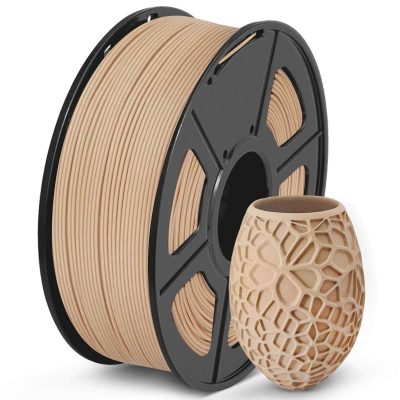- Last Updated: January 12, 2024
-
 Jackson O'Connell
Jackson O'Connell
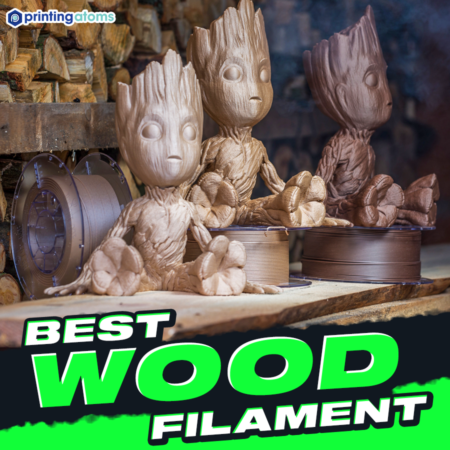 Wood PLA filament is a special composite filament that makes your 3D prints look like they’re made out of… you guessed it… wood!
Wood PLA filament is a special composite filament that makes your 3D prints look like they’re made out of… you guessed it… wood!
It’s a mix between raw PLA plastic, wood particles, and some other too-sciency-to-name additives that make for a fabulous surface finish on prints.
Wood filaments are an ideal choice for those looking to make display pieces that have very forestry and cabin-like aesthetic. And, as this filament has been growing in popularity rapidly, many manufacturers have stepped up to the plate to take a hit at this composite filament.
So, if you’re looking for the best wood filament, look no further! Below, we’ve gone over some details about this type of filament, like how you can print it, as well as reviewed some of the top wood filaments on the market.
Enjoy!
Table of Contents
Best Wood Filaments At A Glance
1. Fillamentum Timberfill (Best Choice)
2. 3D Best Q (Best Value)
3. ColorFabb (Premium Choice)
4. Hatchbox
5. Amolen
6. Sunlu
Best Wood PLA Filaments
Now that you know all about wood PLA and why you might want to use it to achieve a specific visual effect on prints, you might be wondering what your options are. Due to the hype around this type of filament, there are many options, and we’ve gone over some of the best ones in the sections below to help you find the best wood filament for you!
Fillamentum is one of the most respected manufacturers of filament, known for making premium and reliable spools. Timberfill is Fillamentum’s line of wood-infused PLA filament, and it’s my personal favorite choice on this list.
While the filament costs decently more than other options on this list, its visual effect on prints is astonishing. It makes your prints look like they were carved out of a tree… hopefully not yours, though.
However, this isn’t too much of a surprise, considering this filament is made up of 15% wood fibers.
And, even better, Timberfill comes in four colors that each match different shades of trees. Unfortunately, this filament is known to be pretty brittle, so parts made with the material should only be used for display. However, if you really want a functional print in Timberfill, using a high infill density and large layer height worked for us in making prints much stronger.
Pros
- Very visually appealing wood appearance on prints
- Four color options
- Not abrasive (minimal nozzle wear)
- Can be stained after printing (just like real wood)
Cons
- Relatively expensive compared to other wood filaments
- Hygroscopic (sensitive to moisture)
- Brittle and weak
3D Best Q, although not widely known, does not fail to provide customers with the best quality filament for the best value. The company offers two options for their wood filament, including a deep rosewood colored filament and a lighter wood colored filament.
The affluence of good reviews around this filament reflects highly on 3D Best Q’s product. Moreover, many mention that the filament offers a good mix between printability and wood-look-a-likeness, especially for the price.
According to the manufacturer, the wood composite filament is 30% real wood-infill. This yields a pretty realistic wood finish on the exterior of prints. However, it’s worth mentioning that the smell this filament produces is noticeable and not exactly a Febreeze top-seller.
On the upside of this filament, though, clogging isn’t said to be very frequent. While an occasional clog on some cheap brass nozzles is inevitable, you won’t have to worry about mid-print-fails due to your nozzle every time your start a print job.
Pros
- Looks amazing once the print is done (pictures do not do it justice)
- Good anti-aging (printed parts do not degrade)
- Compatible with a variety of FDM 3D printers
- Yields a very elusive wood texture on models
Cons
- Noticeable smell
- Some post-processing is necessary
- Layer adhesion isn’t as good as normal PLA (not recommended for functional parts)
- Some nozzle issues occasionally
Founded in 2013, ColorFabb has grown to be a reputable brand for 3D printing filaments. It has set the bar high for many other brands, especially with the release of metal composite filaments, and is one of the best brands when it comes to 3D printing filaments.
The company’s first specialty filament was their wood filament, woodFill. The filament is described to be easy to print and is a composite of recycled wood fibers and ColorFabb’s signature PLA/PHA compound. ColorFabb also produces the wood-based filament, corkFill. This filament is a mix of cork material and PLA plastic, making for a very chocolatey color…and, no, it’s not edible for all of you candy-lovers.
Although these filaments are on the pricey side, they are definitely worth it. The prints practically feel like real wood and smell nice while printing. The filaments are also easy to print in relation to other filaments and are able to sand down quite easily. Additionally, prints respond well to wood staining chemicals.
Something to look out for with ColorFabb’s wood filament is its printability. While we had a good experience testing the product on our direct drive Ender 3, users with a Bowden-drive printer noted that they experienced a lot of stringing. This isn’t uncommon with Bowden-style printers, so we suggest some temperature tuning and retraction adjusting to prevent this from happening.
Overall, ColorFabb woodFill and corkFill are both wood filaments worthy to be on this list. But you might only want to purchase them if you’ve got the dough and want mo’ of a wood-like appearance for prints. Of course, no product is without its flaws, and ColorFab wood filaments’ proneness to stringing is definitely a downside. Luckily, it can be prevented, so you shouldn’t fret too much about it.
Pros
- Options between WoodFill and CorkFill
- Final finish is amazing
- Worth the price
- Easily sanded
Cons
- Pricey, probably the most expensive on the market
- Potential stringing problems
- Some Nozzle problems
Based in the United States, Hatchbox is another filament brand company offering a variety of filaments like ABS to several specialty filaments. One of their specialty filaments includes the company’s wood filament.
Hatchbox’s wood filament is relatively more environmentally friendly as it is composed of wood fibers, plant-based materials, and polymers.
Overall printing with the filament is good and pleasant when it comes to both the quality and smell of the print. The finished prints are detailed and wood-like. Additionally, Hatchbox’s wood filament is reasonably priced, so you won’t have to worry about breaking the bank to get your hands on this high-quality option.
Of course, all products have their flaws, and Hatchbox’s is stringing, which is a very common occurrence for their wood filament. You also need to have a larger-than-normal nozzle to print this filament. That’s because regular 0.4-mm nozzles have been known to clog due to the large wood particles mixed in the filament. Regardless, Hatchbox’s wood filament has great potential for appealing prints.
Pros
- Wood-like finish
- Few to no clogging problems
- Prints, sands, and stains well
Cons
- Stringing is an issue
- Known to be relatively brittle
- Without a heated bed, it’s harder to get the filament to stick
Amolen tech, a 3D filament company established in 2017 produces and sells its own 3D filament brand– Amolen. The company manufactures various specialty filaments from glow in the dark filaments to color-changing filaments, and of course wood.
Amolen is known for the variety they offer, and the same is true for their wood filament, which comes in a few different colors. You can choose between dark wood walnut, redwood, rosewood, and regular wood. Personally, my favorite color is the walnut option, but if you’re indecisive, Amolen’s variety pack might be a better option for you.
As for the technical specifications, Amolen’s wood filaments contain up to 20% wood particles. While this is a decently high percentage, it’s worth noting that the filaments don’t always yield a surface finish that’s identical to wood. This is especially true for the red wood and regular wood filament options.
Don’t be discouraged, though, as Amolen is still a great option if you’re willing to put in some extra time for post-processing prints. Additionally, the printing temperatures are just like normal PLA, so no extra-powerful hot end is needed. Still, don’t expect too easy of a printing experience as Amolen’s wood options are known to be pretty abrasive and subject to nozzle clogs.
Pros
- Highly compatible with printers
- Relatively inexpensive and a good bang for your buck
- Variety of wood filament options
Cons
- Clogging problems with nozzle
- Can be difficult to work with
- Inconsistent surface finishes
Sunlu sells various products to its customers: 3D printers, 3D pens, filament dryers, and filament. The company is known for its variety of quality materials which are sold at reasonable prices to customers– especially with filament.
Sunlu offers one option of wood filament which is a mixture of 20% recycled wood fibers with polymer. The company released their wood filament in 2019 which has flourished since then.
Sunlu’s wood filament is recommended to be printed at 180 °C, but some customers had to increase the nozzle temperature up to 200 °C. Stringing occurs often with prints but easily comes off with some light rubbing. A heated bed is also recommended.
This brand of wood filament is lighter in comparison to Hatchbox wood and is not recommended if you need something strong like PETG. One customer even pointed out that the filament is more plasticky and the result isn’t as fibrous.
Pros
- Relatively less pricey
- Finish has a very visually-appealing wood-like texture
- Good filament for the money
Cons
- Stringing problems
- Not as strong as other wood filament options
- Finish does not feel wood-like
What Is Wood PLA?
Wood PLA is a type of composite filament, made of mostly PLA, but with some wood fibers mixed in to make prints resemble real wood. Wood PLA is a great option for those making display pieces who want to achieve a unique wood-like appearance. And, wood PLA also is pretty easy to print as it’s mainly made of PLA, perhaps the easiest printing material.
For some background, wood filaments were originally developed in the early days of the Rep-Rap project (circa 2012). However, it wasn’t until COVID-19 that wood filaments really started gaining traction as the lockdown hobbyists found a need for it for all sorts of prints: vases, cosplay, desk toys, etc.
As for the actual filament, this type of filament is a composite option. This means it’s a mix between base plastic material and a list of additives that make the filament blend special. In the case of wood filaments, the base material is PLA plastic (the most popular printing material) and the additives mainly consist of wood particles.
Yep, that’s right, real wood particles!
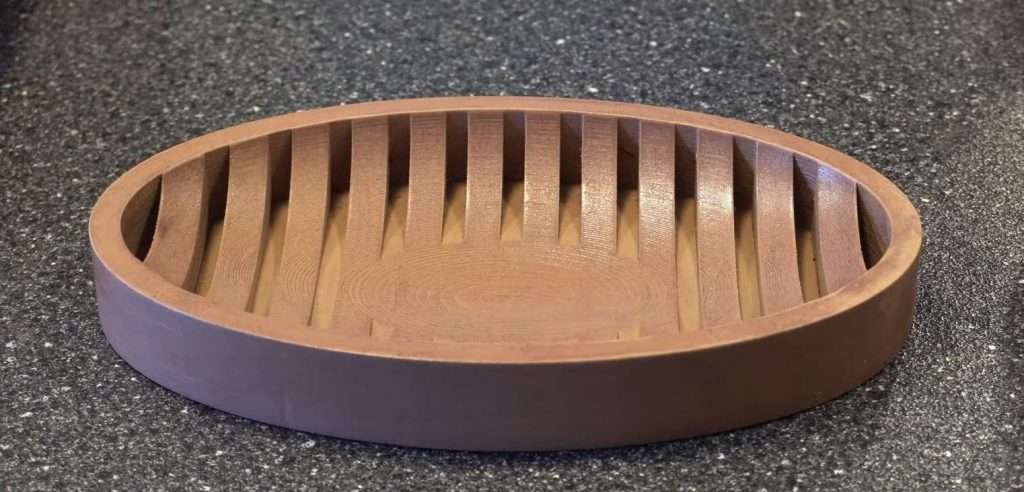 Source: Youtube 3D Printscape
Source: Youtube 3D Printscape
While the percentage is pretty low, with most wood filaments only containing around 30% wood additives and 70% PLA plastic, it’s still enough to make prints look like they’re made of real wood.
Unfortunately, like many composite filaments (e.g. carbon-fiber-infused PLA), wood filaments are very abrasive. This means it’s a rough filament to print with, so it degrades the nozzle rapidly, leading to more frequent jams and clogs.
Still, this doesn’t necessarily mean wood filaments are difficult to print, it just means they can mess up your printer once in a blue moon. Moreover, as a PLA-based filament, wood PLA is still much easier to print than alternative printing materials like ABS and polycarbonate.
Wood filaments have some other aces up their sleeves too. Moreover, many wood filaments can be post-processed just like your regular 2×4 from Home Depot. So, you can stain and paint wood 3D prints easily.
Of course, we also can’t forget to mention that your wood PLA 3D prints will also be pretty weak, and nothing compared to the strength of real wood. Additionally, while real wood performs well outside, when put under the sun (UV light), PLA parts deform.
Nonetheless, wood filament is still a great option as it boasts the visual appearance of real wood while giving you customization through its ability to be 3D printed. Additionally, wood filament comes in a wide array of colors that match different types of wood, like redwood, cork, pine, and more.
Is Wood Filament Actually Wood?
Now, for the big question: is wood filament actual wood? We hate to disappoint, but the answer truly is “it depends”.
As we mentioned, wood filament usually contains around 30% wood particles and similar additives. However, not all of that 30% of additives are actually derived from wood.
While the exact makeup of this 30% varies filament-to-filament (look in the technical and safety data sheets), it’s safe to say about half of this isn’t real wood particles. Instead, it’s either additives that enhance non-visual factors like strength and printability, or additives that change the color of the filament to look like real wood but aren’t actually from wood.
So, the 30% wood component we previously described is actually probably closer to 10-20%. And, is this enough to call wood filament real wood? Well, that answer is up to you!
How To Print Wood Filament? Print Settings Explained
Printing with wood filaments is surprisingly similar to printing with regular PLA, but with slightly higher temperatures.
It’s not too hard, but in this section, we will get into what to watch out for when using wood filament in your prints and useful tips that will come in handy!
To start off, the first thing is to attend to the printer’s temperature settings. It is important to preheat the printer’s hot end. The exact temperature to preheat your printer’s hot end depends on the type of wood filament.
Generally, the preheat temperature for wood filament ranges from 170 to 220 °C. Different temperature settings in the hot end results in different finishes and colors. Higher temperatures create darker shades as wood fiber burns at higher temperatures while lower temperatures result in lighter shades.
However, it is important to not set the hot end at a temperature that is too high! Considering that wood is highly flammable, prints can catch on fire and get damaged if the hot end is too hot.

Heated print beds are also recommended to crease quality prints with wood filament, but not necessary. If a heated print bed is available, it is recommended to preheat the print bed somewhere between 50-70 °C.
While heated print beds aren’t always required, having an adhesive surface is absolutely necessary so the parts do not slide around while printing. Adhesive surfaces can be made with tape and glue among other materials.
Once the hot end and print bed are taken care of, the nozzle is the next course of action!
For the wood filament, nozzles larger than 0.4mm are recommended. Also, nozzles must be kept clean! The nozzle needs to extrude filament fast enough to avoid clogging and the print getting damaged. When it comes to slicer settings, testing with different settings usually helps with oozing and stringing problems.
Once the 3D print is complete, it is time for you to put your own touches on it (only if you want of course). Whether it’s coloring, sanding, or staining, anything is possible! Have fun with it! The sanding process of 3D printing wood is similar to normal wood.
A stain can be used to create a different surface finish since objects 3D printed are porous like real wood. You could even consider adding decoration or carving to your finished print with a CNC machine, laser cutter, or engraver.
Conclusion
Overall, wood filament is a great option if you’re looking to spice things up on your 3D printer. The wood-like surface finish it provides for 3D prints is outstanding, making this type of filament a must-have for those interested in printing cosplay equipment, display pieces, and more.
And, with some post-processing, it will be hard to tell that your model was 3D printed at all!
With many wood filaments to choose from on Amazon’s never-ending search results, you may be confused as to which wood filament you should purchase.
So what’s the best wood filament?
Personally, I like Fillamentum’s Timberfill the best as this wood filament performs well across the board, yielding perhaps the best wood-like surface finish I’ve ever seen. But, if you’re on a budget, the wood filaments from 3D Best Q are a good bang for your buck. On the flip side, if you’ve got some extra cash in your 3D printing budget this month, ColorFabb’s woodFill and corkFill are two amazing wood filaments.




